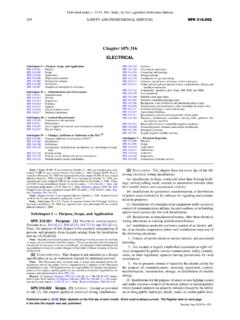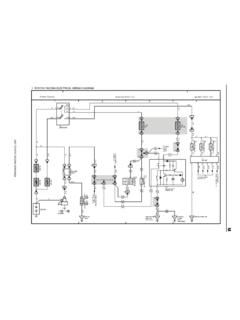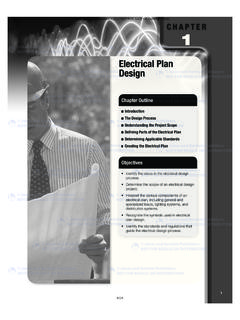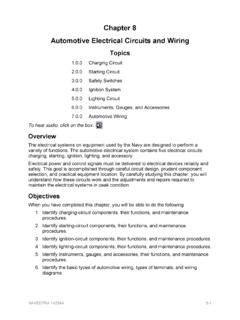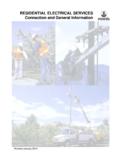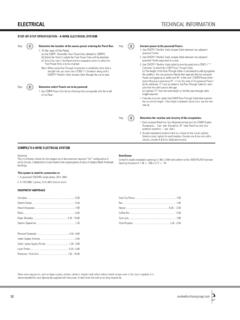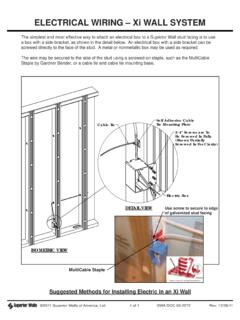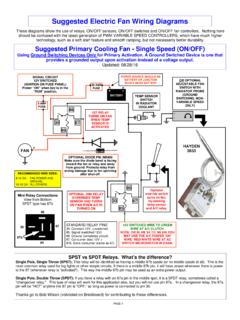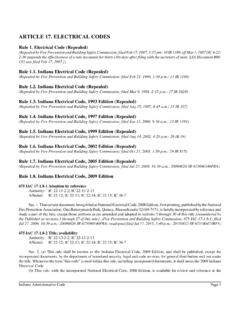Transcription of 1: Aircraft Wiring System (EWIS)
1 Slide 1: Aircraft electrical Wiring Interconnect System ( ewis ) Best Practices Job Aid Revision: [Speaker notes] This job aid covers applicable 14 CFR part 25 Aircraft (although it is also widely acceptable for use with other types of Aircraft such as military, small airplanes, and rotorcraft). This job aid addresses policy; industry ewis practices; primary factors associated with ewis degradation; information on TC/STC data package requirements; ewis selection and protection; routing, splicing and termination practices; and ewis maintenance concepts (including how to perform a ewis general visual inspection). The job aid also includes numerous actual Aircraft ewis photos and examples. [End speaker notes] Slide 2: Additional Notes This slide does not pertain to this accessible version: This presentation contains additional speaker notes for most slides. It s advisable to read these notes while viewing the slide presentation Slide 3: Printing the Additional Notes This slide does not pertain to this accessible version: To print the slides and accompanying speaker notes: Navigate back to the FAA Aircraft Certification job aids web page Open and print Printable Slides and Notes.
2 Slide 4: Background 1. Why the need for ewis best practices Job Aid? a. Accident/Incident Service History b. Aging Transport Systems Rulemaking Advisory Committee (ATSRAC) c. Enhanced Airworthiness Program for Airplane System (EAPAS) d. EAPAS Rule Making [Speaker notes] Historically, Wiring and associated components were installed without much thought given to the aging aspects: Fit and forget. Unanticipated failure modes and their severity. Arc tracking. Arcing. Insulation flashover. Maintenance programs often did not address these aging aspects. Service history also indicates that Foreign Object Damage (FOD) such as drill shavings, caustic liquids, etc. does cause ewis degradation that can lead to ewis faults. [End speaker notes] Slide 5: Introduction Late 1980s, Wiring safety concerns raised due to accidents & incidents Investigations found common degrading factors in airplane electrical Wiring systems Investigation into Wiring issues done by industry, civil aviation authorities, other government agencies [Speaker notes] The aging issues in Wiring systems were made known by the following: In the late 1980s, Wiring safety concerns were raised due to accidents & incidents Investigations found common degrading factors in airplane electrical Wiring systems Investigation into Wiring issues done by industry, civil aviation authorities, government agencies [End speaker notes] Slide 6.
3 Wiring Investigation Findings Design Maintenance Operation Training Repair Installation [Speaker notes] As listed here, the investigation of the Aircraft Wiring revealed there are several factors, together with time, that play a role in Wiring degradation. [End speaker notes] Slide 7: Aging Transport Systems Rulemaking Advisory Committee (ATSRAC) Phase I Tasked to develop and propose recommendations for airworthiness enhancements to the FAA. Tasks completed and reports approved by ATSRAC in January 2001. Phase II Tasked to developed and propose airworthiness enhancements based on the recommendations developed in Phase I. Tasks completed and reports approved by ATSRAC in January 2003. Phase III Tasked to assist FAA with the implementation of the enhancements developed in Phase II. [Speaker notes] Aging Transport Systems Rulemaking Advisory Committee Phase I The following tasks were undertaken by ATSRAC in this phase for developing and proposing recommendations for airworthiness enhancements to the FAA: Sampling inspection of the fleet Review of fleet service history Improvement of maintenance criteria Review and update standard practice for Wiring Review air carrier and repair station inspection and repair training programs Phase II The following tasks were undertaken by ATSRAC in this phase to develop and propose airworthiness enhancements based on the recommendations developed in Phase I.
4 Improving wire System certification requirements Enhancing Wiring maintenance procedures and instructions Enhancing and augment current training programs Standardizing the format of Standard Wiring Practices Manual Study of aging issues in small transport airplanes electrical Wiring Phase III The following tasks are currently undertaken by ATSRAC in this phase to assist FAA with the implementation of the enhancements developed in Phase II: Provide assistance in implementation of the airworthiness enhancements and, if requested, develop alternatives to rulemaking for implementation of training and maintenance enhancements. Assist in review and implementation of new technologies developed for mitigating the aging issues in Aircraft Wiring systems. Study and develop enhancements for Wiring maintenance procedures for small transport airplanes (with a passenger capacity between 6 to 30 and less than 7,500 pound payload).
5 [End speaker notes] Slide 8: Routing/Chafing In Service Examples [Graphic] Wires chafing against metal frame and chaffng against each other [End graphic] [Speaker notes] These photos show examples of findings. These examples show the potential for chafing and arcing. [End speaker notes] Slide 9: Accumulation of Dirt and Lint [Graphic] Wires covered in dirt and lint [End graphic] [Speaker notes] Accumulation of dirt and lint create a potential for smoke and fire, making inspection of the ewis impossible. [End speaker notes] Slide 10: Coil and Stow In Service Example / Result [Graphic] Cut wires with ends exposed and cut antenna that is exposed [End graphic] [Speaker notes] This slide shows an example of improper termination of unused wires. On the left side, there are no termination caps and it s improperly stowed. On the right side is a photo of an improper maintenance action. Coaxial cable was left attached to an antenna instead of being removed in its entirety at least it should have been detached from the antenna.
6 Consequently, lightning attached to the antenna, traveled along the ewis , and caused a fire in the cabin. [End speaker notes] Slide 11: Bend Radius Problem In Service Example [Graphic] Wires bent 180 degrees and bundled together [End graphic] [Speaker notes] This photo shows an improper bend radius installation of electrical wire. The proper bend radius for wire on Aircraft should be 10 times the outside diameter of the largest diameter wire in the bundle for one side supported (3 times for two sides supported.) Standard industrial practice and is in AC 1b and Standard Wiring Practices Manual (SWPM). [End speaker notes] Slide 12: Arcing Event [Graphic] Arcing results with terminals and wires [End graphic] [Speaker notes] These photos illustrate an improper maintenance action caused when the airplane s airworthiness certificate was relocated. The attach screw penetrated the power cables. The FAA maintenance inspector riding on the jump seat caught his clothing on fire.
7 The arcing event, which originated from inside the electrical power center, burned a hole through the left side of the hallway (looking forward) between the cockpit and cabin. [End speaker notes] Slide 13: Effect of Improper Maintenance [Graphic] Top shows chafing wires caused conduit burn through on generated power feeder in conduit. The bottom shows that heat from arcing caused holes in fuel line. [End graphic] [Speaker notes] The left side of this photo shows failure of wire due to chafing inside a metallic conduit. Created an arc, which created holes in the fuel line below the conduit. Caused by improperly replacing an existing power feeder. [End speaker notes] Slide 14: Effect of Poor Design [Graphic] Burn holes on side of airplane and in the floor under a passenger seat [End graphic] [Speaker notes] This shows arcing due to lavatory servicing lines leaking on damaged ewis , creating an arc that caused a fire that led to extensive damage inside and outside of the airplane.
8 Business class lavatory drip shield not installed water shorted cannon plug in wire bundle below deck. Maintenance, design, training, operations all need improvement. [End speaker notes] Slide 15: Previous Regulations Inadequate Previous regulations fell short of providing specific Wiring related requirements. Specific Wiring related requirements needed to be included in certification and operational regulations. Slide 16: Culture Shift: EAPAS Safety Initiative Recognizing importance of ewis in safe operation of airplanes leads to being more proactive; FAA is o Treating Wiring as a System o Mandating DAH support of the initiative o Integrating FAA lines of business; joint AFS/AIR activity; and cooperation with & between DAHs and operators [Speaker notes] To completely and thoroughly address the aging issues in Aircraft Wiring required a cultural shift comprising of: Recognizing importance of electrical Wiring in safe operation of airplanes leads to being more proactive; FAA is Treating Wiring as a System Mandating DAH support of the initiative Integrating FAA lines of business: joint AFS/AIR activity.
9 And cooperation with & between DAHs and operators [End speaker notes] Slide 17: Goal of EPAS Rule Banner with motto: Enhance safety by improving all aspects of Aircraft electrical Wiring Goal is based on o Industry/government committee data driven recommendations o Maximizing harmonization [Speaker notes] The goal of EAPAS was to enhance safety by improving all aspects of Aircraft electrical Wiring Goal is based on Industry/government committee data driven recommendations Maximizing harmonization with international authorities So now you hopefully have a better understanding of the history behind the EAPAS rulemaking and how it came into being. We are next going to provide a definition for an ewis . [End speaker notes] Slide 18: ewis E electrical W Wiring I Interconnection S System [Speaker notes] Wiring needs to be treated as an important System on airplanes. Wiring is now referred to as the electrical Wiring Interconnection System ( ewis ).
10 [End speaker notes] Slide 19: ewis Definition An ewis isis [per new (a)]: Any wire, Wiring device, or combination of these, including termination devices, installed in any area of the airplane for the purpose of transmitting electrical energy between two or more intended termination points .. Slide 20: .. EEWWIISS iiss notnot [ (a)] electrical equipment or avionics qualified to acceptable environmental conditions and testing procedures Portable electrical devices not part of airplane s type design Fiber optics Slide 21: Key Point to Remember .. WWiirree aanndd aassssoocciiaatteedd ccoommppoonneennttss nnooww ttrreeaatteedd aass aann aaiirrppllaannee ssyysstteemm Slide 22: ewis Degradation Factors [Graphic] In the center, ewis Degradation surrounded Physical Properties, Age, Installation, Maintenance and Environment pointing into ewis Degradation. [End graphic] [Speaker notes] ewis degradation ewis degradation is a process that is a function of several variables; aging is only one of these.










